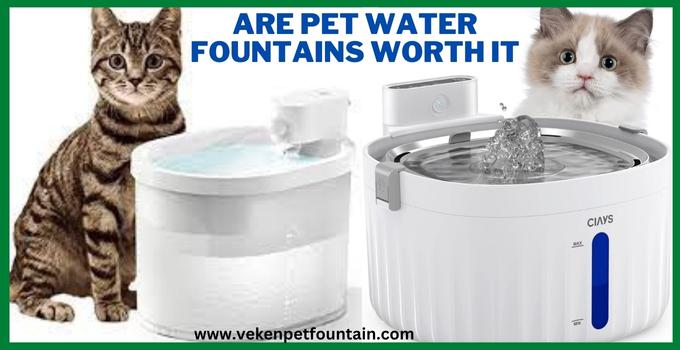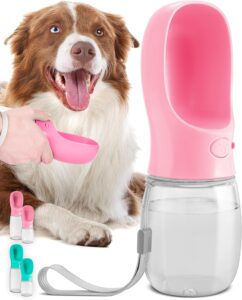Are Pet Water Fountains Worth it? (Read Pros & Cons)
Last updated on March 24th, 2024
When considering a purchase, it always pays to take a good look at the pros and cons. To help you decide whether or not pet water fountains are worth it, here’s an honest review of the best pet water fountains on the market today along with thorough answers to common questions.
If you’ve been considering buying a water fountain for your pet to enjoy, then this will be the most important article you read before making that choice. What I’m about to tell you could save your animal’s life. You will understand how these products really work and gain invaluable insights that you can use to make the best decision for your pets.

In fact, having too much water can also be dangerous and even fatal for them. That is why pet water fountains have become so popular in the United States these days. However, are pet water fountains worth it? If you are thinking about getting one for your pet (or pets), then this article will help provide everything you need to know about these devices.
🐾Portable Pet Water Bottle🐾

Why does it matter where your pet drinks from?
Most of us don’t think about it, but where your pet drinks from is a crucial part of their health and well-being. Even if your dog or cat never goes outside, they still need clean water to stay healthy — after all, they drink it directly from their water bowl.

If your pet’s water bowl sits on the floor or near the floor, it could be contaminated with bacteria like Salmonella and E. coli, which can make them sick. The same goes for other household surfaces like countertops or tabletops that aren’t cleaned regularly.
Dogs and cats can also pick up diseases while they are outdoors, such as leptospirosis — a bacterial disease spread through rat urine that can cause fever, vomiting and diarrhea in dogs — or coccidiosis — a parasitic infection that causes diarrhea in both dogs and cats.
The following is a list of some common contaminants found in drinking water:
Arsenic
A naturally occurring element that has industrial, medical and agricultural uses. Arsenic is a poison that can cause cancer and other health problems in humans and animals if ingested over an extended period of time.
Lead
Can be found in old lead paint or plumbing materials, it can cause damage to the nervous system, kidneys and intestines.
Nitrates
Found in fertilizers used on lawns and gardens, nitrates can cause illness or even death in pets who ingest them.
Chlorine
Used as a disinfectant for water supplies; chlorine causes irritation of the mucous membranes of the eyes, nose, throat and lungs; excessive exposure may also result in damage to red blood cells.
Do pets need to drink from a flowing and cool water source?
Pets do not need to drink from a flowing and cool water source. In fact, they can take all the water they need from their regular food and water bowls.
The fact that dogs lap up water is just a habit they have developed over time to get the most out of their meal. Some pets may prefer to drink from a flowing and cool water source like a running tap or faucet, but it is not necessary for them to do so.
Pets can also get their daily intake of water through their food. This means that it doesn’t matter how much water you give your pet as long as it gets enough nutrients through its diet.
Yes, pets need to drink from a flowing and cool water source. In fact, it is important that they do so because of their unique physiology and anatomy.
Pets have different ways of cooling themselves than humans do, but they still need fresh water every day. It is also more difficult for them to get the amount of fluid they need in hot weather because they are less likely than humans to sweat profusely.
It’s important to make sure your pet has access to fresh water at all times. If you don’t provide a constant supply, try using a water fountain or bowl that has a constant stream of moving water.
Read Also: Are There Any Battery-Operated Pet Water Fountains?
What are the drawbacks of having a static water source?
Many people are opting for static water sources because of their simplicity, but there is a lot more to consider when choosing this option. Here are some of the drawbacks of having a static water source:
- The first is that the water is not always available. The water can be contaminated, or there may be no way to transport it to where it needs to go. This means that people who live in areas of the world with limited resources will have difficulty obtaining clean drinking water.
- Another issue is that water sources can dry up during droughts or other climate changes such as floods or hurricanes. This is especially problematic in areas where people depend on rainwater for their drinking water sources; if there are no rains, then there will be no water available for them to drink.
- The final drawback of having a static water source is that it can cause problems when you need more than one type of water at once, such as if you need both clean drinking water and washing machine water at home. If you don’t have access to both types of water at once, then you may need two separate systems or two separate tanks for each type of use.
- Static water sources require an electricity source. If you’re on a secluded property and have no way of accessing electricity, you may need to consider another option.
- Static water sources can be costly if you don’t already have one in place. The cost can be anywhere from $1,000 to $10,000 depending on your needs.
- If you want to use your static water source for household purposes such as flushing toilets or washing dishes, it won’t be enough unless you purchase additional tanks or pumps that run off solar power or battery power.
Are there any concerns about bacteria in the water?
Yes, there are concerns about bacteria in the water. Bacteria are living organisms and they can be found everywhere in nature. Some bacteria are helpful to humans, but others can cause serious health problems.
The main concern with drinking water is that it may contain disease-causing bacteria and parasites that can make you sick. These bacteria include:
- Campylobacter jejuni (a leading cause of bacterial diarrhea).
- Escherichia coli (E. coli) (also known as Shigella) – a type of coliform bacterium found in the lower intestines of humans and animals; E. coli O157:H7 is the strain that causes foodborne illness.
- Giardia lamblia – an intestinal parasite found worldwide; causes diarrhea, abdominal cramps, bloating, nausea, and fatigue and weight loss.
- Salmonella typhi – a type of nonmotile gram-negative coccobacillus bacterium commonly known as typhoid fever; often spread through contaminated food or water.
How else do pet fountains help my pet drink more water?
Pets need to drink more water than their owners. That’s because they have a higher metabolic rate and are always moving around. So, how else do pet fountains help my pet drink more water?
- Pet fountains help pets drink more water because they’re constantly flowing with fresh, clean water.
- Pet fountains keep water moving and aerated which helps keep it fresh and clean for your pet.
- Water fountains also help prevent your pet from developing urinary tract infections (UTIs), which can be caused by bacteria that live in the bladder wall or kidney tubes that contaminate their drinking water when it sits still in a bowl for long periods of time. This is especially important for male dogs who have a longer urethra than female dogs and therefore have a harder time flushing out bacteria from their bladders after they urinate (just like men!).
Conclusion: Are Pet Water Fountains Worth it
Are pet water fountains worth it? Pet water fountains are great for pets. It is large in size and runs quietly. We have not heard of any complaints about it whatsoever. Get one for your pet today and reduce the amount of money you spend on veterinary visits.
In the end, those looking for a cool new way to keep their pets cool – or their cats from hogging the hose – may be interested in giving pet water fountains a try. For the price and their effectiveness, it’s hard to pass up this type of technology.
When it comes to picking the best pet fountain for your cat, dog, or another four-legged animal, you should consider a few key points. For example, how do you feel about a unit that requires manual cleaning? Do you want a large-capacity reservoir? Perhaps the noise level is important to you. If you have trouble deciding between the numerous pet fountains available online and in stores, keep the points above in mind.
They’re relatively easy to use and clean, as long as you follow the manufacturer’s instructions for proper care.
They’re also durable, and long-lasting—we recommend getting a good quality fountain that will last you several years of use—and they can be customized to help different pets in different ways: some have a splashproof layer that keeps curious dogs from draining the bowl altogether; others are designed specifically for cats with smaller mouths or sensitive stomachs. Bottom line: if you want your animal companion to thrive, consider investing in a good water fountain.



